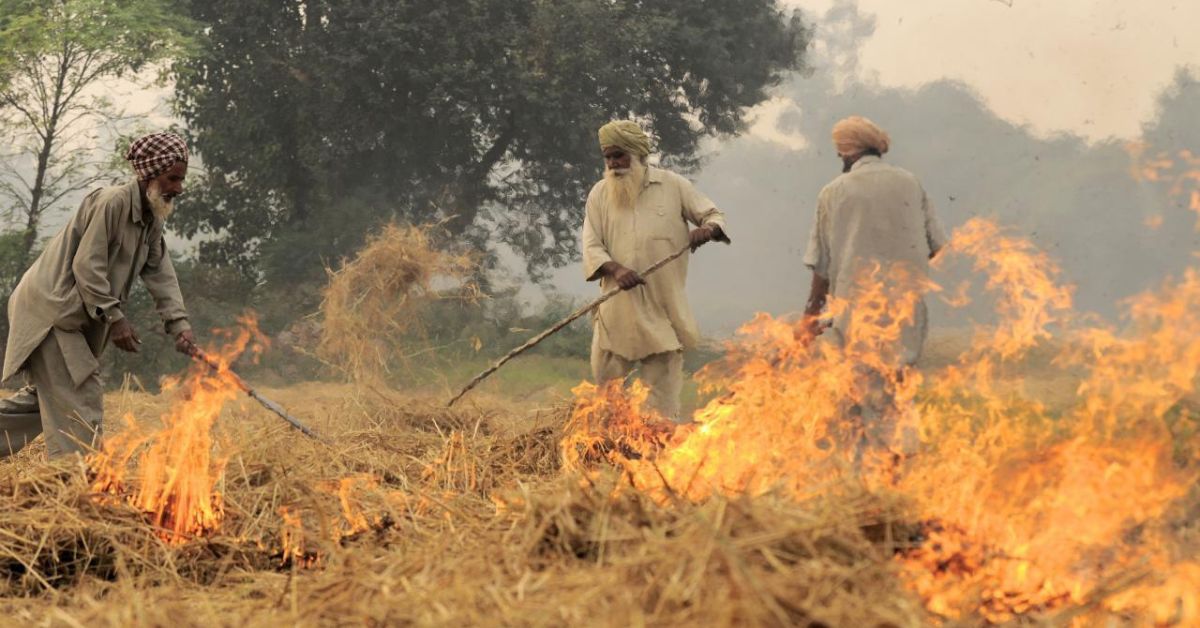How This IAS Officer’s Initiative Reduced Stubble Burning in Ambala by Over 80%
Former IAS officer of Ambala, Vikram Yadav, used unique methods to reduce stubble-burning incidents by approaching farmers with attractive waste management alternatives. After an 80% reduction in farm fires in 2021, a further dip was witnessed this year. Know more.

This article has been sponsored by Wingify Earth.
The winter season in Delhi once welcomed as a relief from its burning summers, now only brings in the terror of smog and pollution. The rise in toxins often leads to severe health issues among the residents of the national capital. Year after year, pollution levels continue to rise with the onset of the cold season, a big cause of which is stubble burning across the northern states of Punjab and Haryana.
Delhi witnessed a peak AQI of 303 this time around on the morning after Diwali. With smoke from stubble burning being the highest contributor to this pollution, it has become a worrying cause for administrations across Delhi, Punjab, and Haryana.
However, unique solutions by an IAS officer in Haryana helped to reduce stubble burning in the district of Ambala, which, until two years ago, witnessed at least 5,328 incidents of farm fires.
Vikram Yadav, who joined as the district collector in Ambala in June 2021, helped cut down stubble burning in his district by a whopping 80% by providing measures that helped farmers switch to cleaner crop residue disposal alternatives. Within months, Vikram mobilised state machinery to reduce stubble-burning incidents, without any penalties for farmers.
Burning paddy stubble is a common activity among many farmers, primarily because it is a cheap and time-effective solution.

Speaking with The Better India, Vikram explains, “This is inevitable for farmers as they need to clear and prepare the ground for planting the crop for the Rabi season,” adding that this method is preferred by farmers due to the short gap between the seasons.
According to the officer, burning stubble clears the ground for the next harvest overnight, while the other methods require at least a month, which can delay the sowing process.
What was so unique about Vikram Yadav’s solutions?
As soon as he joined the Ambala district administration, he began studying the data and causes of stubble-burning incidents and worked to find possible solutions. He says, “I realised that it was mandatory to approach farmers for in-situ and ex-situ waste management.” The state administration began holding awareness camps and training programmes, much before the onset of the harvest season in September, which helped the district bring down stubble-burning cases without registering a single FIR.

“We began by analysing the severity of the issues and demarcated areas into red and yellow zones. The red highlighted areas with more than six farm fires in a year, while the yellow indicated up to five incidents. The exercise narrowed down eight red zones and 89 yellow zones,” he said.
With a focus on reducing farm fires from the red zone to zero, his team introduced seeder machines, subsidised government equipment and shedders to manage farm waste ethically. The farmers were also offered straw balers with racks, a reversible hydraulic plough, and a rotary slasher to convert crop residue into fertiliser. The farmers were also provided cash for selling the stubble to power plants.
These methods reaped positive results. While 702 cases were registered during the peak stubble-burning period in 2020 (September 15 and October 30), only 146 incidents were registered during the same time frame in 2021.
Vikram adds, “The farmers also chose the options as they received immediate cash payments or money transfers in the waste management process. It became a motivational factor for them. Also, no police cases were registered against the violators, but 41 farmers received fines for burning farm waste.”
While Vikram Yadav is now the district collector of Faridabad, the crucial strategies implemented by him in Ambala have inspired many administrators in the agricultural state. Incidentally, Haryana recorded the lowest number of farm fires this year since 2020, according to the Indian Agricultural Research Institute (IARI). According to the centre, farm fires contributed to only 34% of PM 2.5 pollution this year, as compared to 48% last year.
Additionally, between September 15 and November 25 this year, Haryana witnessed 48% fewer incidents of farm fires compared to the same period last year.
“I hope the initiative’s success remains consistent in coming years and serves as a model for other farmers to prevent stubble burning,” he concludes.
Sources:
Stubble burning counts in Punjab and Haryana lowest since 2020 by Priyangi Agarwal, published on November 24, 2022.
31.5% reduction in paddy stubble burning recorded in these North-Indian states by PBNS, published on December 06, 2022.
Cleanest day-after-Diwali air in Delhi since 2015 by Abhinaya Hargovind, published on October 26, 2022.
(Edited by Pranita Bhat)
This story made me
- 97
- 121
- 89
- 167
Tell Us More
We bring stories straight from the heart of India, to inspire millions and create a wave of impact. Our positive movement is growing bigger everyday, and we would love for you to join it.
Please contribute whatever you can, every little penny helps our team in bringing you more stories that support dreams and spread hope.



















